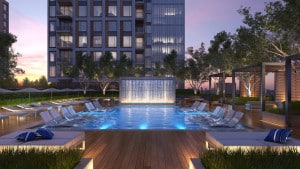Greater Boston’s for-sale housing market has maintained its selling absorption pace throughout 2017. Although slightly off the previous year’s record-breaking sale number of 3,600 units, 2017 still topped off at 3,339 units sold and closed.
Resales are at a premium. With little supply and deep demand, the sales are continuing to move and prices are continuing to climb. 50 Liberty, Pierce Boston and Siena were almost sold out by the end of 2017, prior to their certificates of occupancy. One Dalton continues to herald a new level of pricing with numbers exceeding $2,700 per square foot, and Pier 4 began presales with some of the Seaport’s highest numbers yet – at over $2,600 per square foot.
With the average urban core pricing now exceeding $1,050 per square foot, the speed of the trajectory has slowed slightly, but not flattened. However, the affordability quotient continues to provide the expansion driver for the next tier of development.
Allston, Somerville and Eastie all made their explosive debuts last year. Moving forward, the next waves will be north to Lynn, west past Brighton and south to Quincy. Transit-oriented developments will drive that expansion. Mid-luxury, stick-frame construction can provide affordable new alternatives to expensive urban core concrete and steel product.
Large, mixed-use projects continue to provide that cliché – a work, live and play environment – as commuting becomes increasingly challenging. EchelonSeaport, with over 450 condominiums and 250 rentals, is well under way. Fenway, Ink Block, Assembly Square and the upcoming Washington Village all support the important wave of creating that “sense of place.” Placemaking will continue to be the buzzword of Boston’s future development. Walkability is replacing “drivetime” as a value-add commodity. Convenience, urban living and lifestyle amenities will drive the next wave of absorption.
International Demand is Still Significant
Foreign investment continues to impact Boston’s development scene, at every level of the capital stack. Managing the influx of investors on the retail sale side is an important component of balancing the fabric and community within the buildings, in concert with business success. The demand is still significant for appropriately positioned product and the appetite for housing investment is still very strong in Boston.
In addition to those projects currently in the market, there are several large developments launching late in 2018/2019: Raffles Residences, Quinzani, 150 Seaport and 112 Shawmut among them. Since all are reaching to attain a minimum of $1,500 per foot and up, the demand for that end of the market will soften with the added supply.
However, with our continued economic strength, buoyed by positive global stability, Boston should maintain a steady absorption of the high end. The question will revolve more around pace than price. In contrast, any projects priced under $1,000 per foot will be in hot demand. Those higher luxury projects will sell, albeit with a more conservative timeline then the previous three years. The housing market in Boston is still bright and the runway appears clear for the foreseeable future.
Sue Hawkes is managing director of The Collaborative Cos. of Boston.




 |
| 

